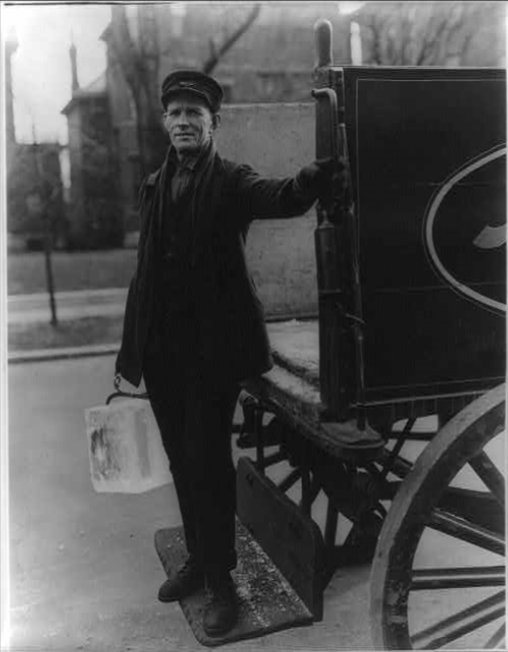1926
12.)Valencia–Jesse Crawford
The Wurlitzer Organ was a popular musical instrument. It was often used in theaters to provide accompaniment to silent films. Here is an example of what the Wurlitzer sounded like.
13.)Any Ice To-Day Lady?–Waring’s Pennsylvanians
Fred Waring and His Pennsylvanians is not a name that is remembered today but back in the 1920s and 1930s they were a popular and well-known dance band. They made the first electric recording in 1925 with their song “Collegiate” (Brooke 1984). While “Collegiate” is a good song, I picked this one because it’s fun and quirky 1920s music at its best, and it highlights what a different world 1926 was. It’s a comedic novelty song about the iceman making a delivery. Back before refrigerators, the iceman dropped off a block of ice, and it would keep your food from spoiling.

1927
14.)Ain’t She Sweet–Gene Austin
Gene Austin is considered to be one of the first “crooners.” When the shift from acoustic to electric recording happened, more natural and intimate sounding performances were captured. Technology changed music. With an acoustic recording, you had to sing/shout into a giant horn. You couldn’t do that to a microphone because the playback would sound horrible, and the microphone could even break. With the new delicate microphones singers had to sing more gently and natural.
1928
15.)You’re the Cream in my Coffee–Annette Hanshaw
Annette Hanshaw was someone who made hundreds of records in the late 1920s and early 1930s. This one is one of my favorites from her. There isn’t really a lot of information out there. The best I can recommend looking at is this jazzage1920s website. There is an interview up on YouTube from the 1970s where she states “I disliked the business intensely. I loathed it, and I’m ashamed to say I just did it for the money. I loved singing, you know, jamming with the musicians when it isn’t important to do, but somehow or another I was terribly nervous when I sang. […] You just have to be such a ham and love performing, and I happen to be an introvert, and I just wasn’t happy singing, and I wasn’t happy with my work as I said” (“Annette Hanshaw Interview With Jack Cullen (1972) Part 1 Of 2”).
16.)Let’s Misbehave–Irving Aaronson and His Commanders
This one is probably familiar to most. A lot of times when the 1920s is being characterized on television or in a movie this song is played to evoke the “Jazz Age.” Despite this fact, there is not much information online about Irving Aaronson and His Commanders. The most information I have ever found about Irving Aaronson and His Commanders is in some liner notes. Rivermont Records put out a really fun retrospective in 2011 entitled “Irving Aaronson and His Commanders: Let’s Misbehave 1926-1928”. The liner notes inside are the most information I’ve ever found. Irving Aaronson was born in 1895. His parents were Immigrants. They were Jews escaping Russia. He came from a big family and was one of eleven children (Sketvedt 2011, 2-3).
From childhood, Irving Aaronson loved playing music. At age 11 he was employed by a nickelodeon that paid him to play piano while silent films played. He first seriously studied music in 1916 when he took classes at the David Mannes School for Music on East 70th Street. The school was named after the concertmaster of the New York Symphony Orchestra. In 1917, he was in his first band, the Versatile Sextette. They lasted through 1923. It isn’t known why they broke up, but the following year Aaronson formed Irving Aaronson and His Crusaders (Sketvedt 2011, 3-7).
Over the course of the next year, they play at hotels, in vaudeville shows, and even on Broadway. In January and March of 1926, they scored a chance to record for Thomas Edison. Edison never released the recordings as he was never a fan of jazz. Shortly after they recorded for Victor Records, changed their name to the Commanders, and their career took off. Over the next few years, they made more recordings, traveled in the United States and Europe, played on the radio, and played on Broadway. They are most remembered for playing music in the musical comedy Paris starring Irene Bordoni (Sketvedt 2011, 7, 11-14).
1929
17.)Am I Blue?–Ethel Waters

Ethel Water’s was born in 1896 in Chester, Pennsylvania. Her early life had many challenges. She grew up very poor and even first married at age 12 and was divorced by age 14. After her divorce, she worked at a hotel in Philadelphia where she did laundry and acted as a chambermaid. While at a nightclub on her 17th birthday she jumped up on stage and sang a song. She was discovered by a vaudeville troupe, Braxton and Nugent, and she played the black vaudeville circuit. She first recorded “race” records in 1921 for Black Swan Records, a short-lived label that specialized in “race” records. During her affiliation with Black Swan, she extensively toured with the Black Swan Jazz Masters. The tour was led by Fletcher Henderson (Tischler 2010). The song “Am I Blue?” was featured in the 1929 musical On with the Show!
Bibliography
“Annette Hanshaw Interview With Jack Cullen (1972) Part 1 Of 2.” YouTube. June 5, 2011.
Brooke, James. “FRED WARING, CONDUCTOR, DIES AT 84.” The New York Times. Last
modified July 30, 1984. http://www.nytimes.com/1984/07/30/obituaries/fred-waring-conductor-dies-at-84.html.
The Iceman. , ca. 1923. Photograph. Retrieved from the Library of Congress,
https://www.loc.gov/item/2012647878/. (Accessed June 08, 2017.)
Skretvedt, Randy. Liner notes for Irving Aaronson and His Commanders: Let’s
Misbehave (1926-1928), Irving Aaronson and His Commanders. Rivermont Records BSW-1155, 2011, compact disc.
Tischler, Barbara L. “Ethel Waters.” American National Biography (From Oxford
University Press) (2010)
Van Vechten, Carl, photographer. [Portrait of Ethel Waters]. , 1940. Photograph. Retrieved
from the Library of Congress, https://www.loc.gov/item/2004663700/. (Accessed June 11, 2017.)

